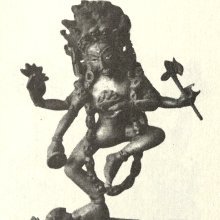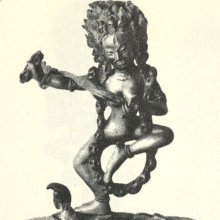Candali, Caṇḍālī, Cāṇḍālī, Camdali: 15 definitions
Introduction:
Candali means something in Buddhism, Pali, Hinduism, Sanskrit, Marathi, Jainism, Prakrit. If you want to know the exact meaning, history, etymology or English translation of this term then check out the descriptions on this page. Add your comment or reference to a book if you want to contribute to this summary article.
Alternative spellings of this word include Chandali.
Images (photo gallery)
In Hinduism
Ayurveda (science of life)
Rasashastra (Alchemy and Herbo-Mineral preparations)
Source: Wisdom Library: Rasa-śāstraCāṇḍālī (चाण्डाली):—One of the sixty-four Divyauṣadhi, which are powerful drugs for solidifying mercury (rasa), according to Rasaprakāśa-sudhākara (chapter 9).

Āyurveda (आयुर्वेद, ayurveda) is a branch of Indian science dealing with medicine, herbalism, taxology, anatomy, surgery, alchemy and related topics. Traditional practice of Āyurveda in ancient India dates back to at least the first millenium BC. Literature is commonly written in Sanskrit using various poetic metres.
Shaktism (Shakta philosophy)
Source: Google Books: ManthanabhairavatantramCāṇḍālī (चाण्डाली) refers to one of the four Goddesses, according to the Ṣaṭsāhasrasaṃhitā, an expansion of the Kubjikāmatatantra: the earliest popular and most authoritative Tantra of the Kubjikā cult.—Accordingly, “[...] One should (also) worship with effort the goddess in the middle of the sacred seats accompanied by the four goddesses and Siddhas [i.e., caturdevī-samāyuktā]. Worship the goddesses Caṇḍeśī, Mahācaṇḍā, Cāṇḍālī, and Caṇḍikā to the sides (of the goddess) ranging from the east to the north. (Commentary):—Who are those (four)? (They are) Ādhārīśa and the rest along with the four, the goddess Raktā and the rest. They are present here with a different name, that is, as Caṇḍeśī, Mahācaṇḍā, Caṇḍālī, and Caṇḍikā. These are the goddesses. Four directions pertain to these goddesses, namely, the east, south, west, and north. The reference to the directions (implies) a reference to the four sacred seats”.

Shakta (शाक्त, śākta) or Shaktism (śāktism) represents a tradition of Hinduism where the Goddess (Devi) is revered and worshipped. Shakta literature includes a range of scriptures, including various Agamas and Tantras, although its roots may be traced back to the Vedas.
In Buddhism
Tibetan Buddhism (Vajrayana or tantric Buddhism)
Source: archive.org: The Indian Buddhist IconographyCaṇḍālī (चण्डाली) refers one of the eight Gaurīs, commonly depicted in Buddhist Iconography, and mentioned in the 11th-century Niṣpannayogāvalī of Mahāpaṇḍita Abhayākara.—Her Colour is blue; her Symbol is the fire-pot; she has two arms.—The seventh goddess in the Gaurī group is Caṇḍālī.
Caṇḍālī is described in the Niṣpannayogāvalī (pañcaḍāka-maṇḍala) as follows:—
Source: De Gruyter: A Fragment of the Vajrāmṛtamahātantra“Caṇḍālī is blue in colour, and holds a fire-pot in her right hand”.
[The left shows the common gesture of tarjanī”.
All the deities are violent in character with fearful appearance and ornaments, and garlands of heads. They dance in pratyālīḍha and show the raised index finger with clasped fist against the chest, as the common gesture.]
Cāṇḍālī (चाण्डाली) refers to one of the eight wisdoms (vidyās) described in the ‘śrīheruka-utpatti’ chapter of the 9th-century Vajrāmṛtatantra or Vajrāmṛtamahātantra: one of the main and earliest Buddhist Yoginītantras. Chapter 8 contains the description of how to visualise Śrīheruka [...] The great Vajra-holder should summon the Glorious form of Heruka, who is devouring the Devas together with Indra, Brahmā, Viṣṇu, and Śiva. Then the text lists the eight Wisdoms (vidyā) [viz., Cāṇḍālī], [...], expounds the words that the practitioner has to mutter when he is pushed by these wisdoms [...].
Source: academia.edu: The Structure and Meanings of the Heruka MaṇḍalaCaṇḍālī (चण्डाली) is also mentioned as the Ḍākinī of the north-western corner in the Jñānacakra, according to the 10th century Ḍākārṇava chapter 15. Accordingly, the jñānacakra refers to one of the three divisions of the saṃbhoga-puṭa (‘enjoyment layer’), situated in the Herukamaṇḍala. Two colors are evenly assigned to the four corner Ḍākinīs [viz., Caṇḍālī] in order in accordance with the direction which they face.
Source: WikiPedia: VajrayanaCaṇḍālī (चण्डाली) (Tibetan: གཏུམ་མོ་, tummo, Wylie: gtum mo) refers to the “Yoga of inner heat (or mystic heat)” and represents one of Nāropa’s Six Dharmas (ṣaḍdharma) in Tibetan Buddhist Tantric practices .—In Tibetan Buddhism, tummo (=caṇḍālī) is the fierce goddess of heat and passion. Tummo is found in the Mahasiddha Krishnacarya and the Hevajra Tantra texts. Tummo is also a Tantric practice for inner heat, developed around the concept of the female deity. It is found in the Six Dharmas of Naropa, Lamdre, Kalachakra. and Anuyoga teachings of Vajrayana. The purpose of tummo is to gain control over body processes during the completion stage of 'highest yoga tantra' (Anuttarayoga Tantra) or Anuyoga.
Source: OSU Press: Cakrasamvara SamadhiCaṇḍalī (चण्डली) or Caṇḍalīyoga refers to “yogic heat”, according to the Anuttarayoga Tantra divisions of Mahāyāna-Vajrayāna Buddhism, according to Buddhist teachings followed by the Newah in Nepal, Kathmandu Valley (whose roots can be traced to the Licchavi period, 300-879 CE).—What makes Anuttara Yoga unique is the nature of the deities visualized, wrathful and erotic, and the level of sophistication of the meditative practices which include caṇḍalī-yoga, "yogic heat", known as "Tummo" in Tibetan, which are breathing exercises using kuṇḍalinī-yoga for generating internal heat originating from the pelvic bowl, utkrānti-yoga, "death yoga", known as "Phowa" in Tibetan, which is transference of consciousness at the time of death, and śmāśāna-yoga, "cremation ground yoga", meditations and ritual magic performed in cremation grounds.

Tibetan Buddhism includes schools such as Nyingma, Kadampa, Kagyu and Gelug. Their primary canon of literature is divided in two broad categories: The Kangyur, which consists of Buddha’s words, and the Tengyur, which includes commentaries from various sources. Esotericism and tantra techniques (vajrayāna) are collected indepently.
Languages of India and abroad
Pali-English dictionary
Source: BuddhaSasana: Concise Pali-English Dictionarycaṇḍālī : (f.) a caṇḍāla woman.

Pali is the language of the Tipiṭaka, which is the sacred canon of Theravāda Buddhism and contains much of the Buddha’s speech. Closeley related to Sanskrit, both languages are used interchangeably between religions.
Marathi-English dictionary
Source: DDSA: The Molesworth Marathi and English Dictionarycaṇḍāḷī (चंडाळी).—f (caṇḍāḷa) Mad or monstrous deeds; a fit of fury or rage; the vehement bellowing and wild frantic action of a child in a passion. v yē. 2 also caṇḍāḷīṇa f A female of the caṇḍāḷa caste. Hence A foul and disgusting, or a fierce, savage, and violent woman.
--- OR ---
cāṇḍāḷī (चांडाळी).—Better caṇḍāḷa &c.
Source: DDSA: The Aryabhusan school dictionary, Marathi-Englishcaṇḍāḷī (चंडाळी).—f Mad or monstrous deeds; a fit of fury or rage.
Marathi is an Indo-European language having over 70 million native speakers people in (predominantly) Maharashtra India. Marathi, like many other Indo-Aryan languages, evolved from early forms of Prakrit, which itself is a subset of Sanskrit, one of the most ancient languages of the world.
Sanskrit dictionary
Source: Cologne Digital Sanskrit Dictionaries: Edgerton Buddhist Hybrid Sanskrit DictionaryCaṇḍālī (चण्डाली).—name of a yoginī: Sādhanamālā 443.16, et alibi; name of a rākṣasī, Mahā-Māyūrī 243.34.
Source: Cologne Digital Sanskrit Dictionaries: Monier-Williams Sanskrit-English Dictionary1) Caṇḍālī (चण्डाली):—[from caṇḍāla] f. ([gana] śārṅgaravādi) idem (one of the 8 kinds of women attending on Kaula worship), [Kulārṇava-tantra vii]
2) [v.s. ...] Name of a plant, [cf. Lexicographers, esp. such as amarasiṃha, halāyudha, hemacandra, etc.]
3) Cāṇḍālī (चाण्डाली):—[from cāṇḍāla] f. a Caṇḍāla woman, [Manu-smṛti viii, 373; Bhāgavata-purāṇa vi, 3, 12]
4) [v.s. ...] (said of a woman on the first day of her courses), [Vetāla-pañcaviṃśatikā i, 10]
5) [v.s. ...] the plant Liṅginī, [cf. Lexicographers, esp. such as amarasiṃha, halāyudha, hemacandra, etc.]
6) [v.s. ...] (with bhāṣā) the language of the Caṇḍālas, [Sāhitya-darpaṇa vi, 163.]
7) Cāṇḍāli (चाण्डालि):—[from cāṇḍāla] m. [plural] Name of a family, [Pravara texts vi, 1.]
Source: DDSA: Paia-sadda-mahannavo; a comprehensive Prakrit Hindi dictionary (S)Caṇḍālī (चण्डाली) in the Sanskrit language is related to the Prakrit word: Caṃḍālī.
Sanskrit, also spelled संस्कृतम् (saṃskṛtam), is an ancient language of India commonly seen as the grandmother of the Indo-European language family (even English!). Closely allied with Prakrit and Pali, Sanskrit is more exhaustive in both grammar and terms and has the most extensive collection of literature in the world, greatly surpassing its sister-languages Greek and Latin.
Prakrit-English dictionary
Source: DDSA: Paia-sadda-mahannavo; a comprehensive Prakrit Hindi dictionaryCaṃḍālī (चंडाली) in the Prakrit language is related to the Sanskrit word: Caṇḍālī.
Prakrit is an ancient language closely associated with both Pali and Sanskrit. Jain literature is often composed in this language or sub-dialects, such as the Agamas and their commentaries which are written in Ardhamagadhi and Maharashtri Prakrit. The earliest extant texts can be dated to as early as the 4th century BCE although core portions might be older.
Kannada-English dictionary
Source: Alar: Kannada-English corpusCaṃḍāli (ಚಂಡಾಲಿ):—
1) [noun] a woman belonging to ಚಂಡಾಲ, [camdala,] a caste.
2) [noun] a woman of highly wicked, heinous character.
--- OR ---
Caṃḍāḷi (ಚಂಡಾಳಿ):—[noun] = ಚಂಡಾಲಿ [camdali].
Kannada is a Dravidian language (as opposed to the Indo-European language family) mainly spoken in the southwestern region of India.
See also (Relevant definitions)
Starts with: Camdalike, Camdalir, Camdalisu, Camdaliya, Candalika, Candalikabandha, Candalikabandham, Candalikashrama, Candalini, Candaliyoga.
Ends with: Ucchishtacandali.
Full-text (+13): Kumbhakari, Camdale, Caturdevi, Pakkanar, Candala, Khattiyi, Rajasvala, Jambavati, Suvannatilaka, Catuhsiddha, Tsandali, Mahacanda, Candeshi, Svacandala, Gopali, Gopala, Nandivardhana, Rtsa, Bdud rtsi, Carmakara.
Relevant text
Search found 27 books and stories containing Candali, Caṇḍālī, Cāṇḍālī, Caṇḍāḷī, Cāṇḍāḷī, Cāṇḍāli, Camdali, Caṃḍālī, Caṃḍāli, Caṇḍāli, Caṃḍāḷi, Caṇḍāḷi; (plurals include: Candalis, Caṇḍālīs, Cāṇḍālīs, Caṇḍāḷīs, Cāṇḍāḷīs, Cāṇḍālis, Camdalis, Caṃḍālīs, Caṃḍālis, Caṇḍālis, Caṃḍāḷis, Caṇḍāḷis). You can also click to the full overview containing English textual excerpts. Below are direct links for the most relevant articles:
Manusmriti with the Commentary of Medhatithi (by Ganganatha Jha)
Verse 11.178 < [Section XIX - Expiation for Wrongful Sexual Intercourse]
Verse 5.154 < [Section XIV - Duties of Women]
Verse 9.4 < [Section I - Husband and Wife]
Dvisahasri of Tembesvami (Summary and Study) (by Upadhyay Mihirkumar Sudhirbhai)
Chapter 6 - Description of holy place called Gokarṇa
Puranic encyclopaedia (by Vettam Mani)
Maha Prajnaparamita Sastra (by Gelongma Karma Migme Chödrön)
Appendix 3 - The journey of the Buddha to the north-west of India < [Chapter XV - The Arrival of the Bodhisattvas of the Ten Directions]
Guhyagarbha Tantra (with Commentary) (by Gyurme Dorje)
Text 16.3 (Commentary) < [Chapter 16 (Text and Commentary)]
Text 15.25 (Commentary) < [Chapter 15 (Text and Commentary)]
Chapter 16 - Emanation of the Maṇḍala of Buddha-speech < [Chapter 16 (Text and Commentary)]
Yajnavalkya-smriti (Vyavaharadhyaya)—Critical study (by Kalita Nabanita)
Chapter 3.2b - Untouchability < [Chapter 3 - The Social Aspect Depicted in the Vyavahārādhyāya]

